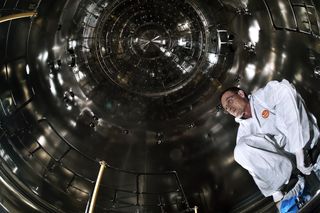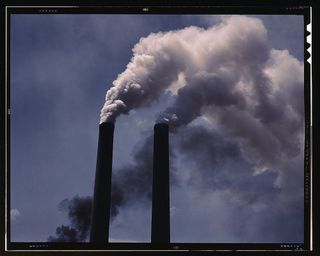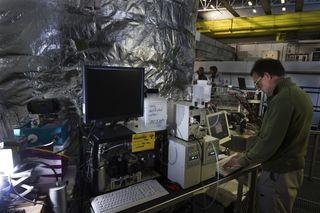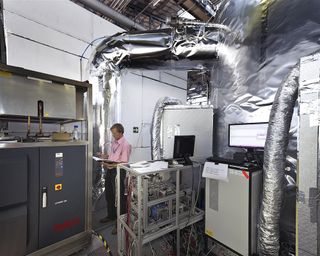A Cloud Is Born: Images of CERN's CLOUD Chamber
CLOUD Chamber

CERN's CLOUD experiment facility in Switzerland is designed to simulate the atmosphere in a closed, controllable chamber. [Read about CLOUD's first results]
Inside a CLOUD

CERN physicist and CLOUD experiment leader Jasper Kirkby crouches inside the CLOUD chamber. The chamber is the cleanest of its kind, allowing researchers to remove almost all contaminants before launching experiments. The air used inside the chamber is synthesized from liquid nitrogen and oxygen because regular air can't be made pure enough for the research's rigorous standards.
Cosmic Chamber

One of the major goals of the CLOUD chamber is to study how much cosmic rays affect cloud formation. Cosmic rays are subatomic particles that enter Earth's atmosphere from the sun and the galaxy at large. They may influence nucleation, the formation of tiny aerosol particles that become the seeds of clouds. Because clouds are a piece of climate change puzzle, understanding how cosmic rays influence them is key to understanding the sun's possible role in climate change.
Cloud Formation

This diagram explains how molecules in the atmosphere coagulate, or nucleate, into aerosol particles. Some aerosols grow large enough that water starts condensing around them, forming the basic unit of clouds.
Aerosols in the Atmosphere

Some aerosols occur naturally. Others, such as sulfur dioxide from power plants, are human-created. Above, World War II-era smokestacks.
Aerosols & Climate Science

Aerosols reflect sunlight back from the Earth, so they're expected to have a cooling effect on the climate. According to NASA, while climate warming will be global, aerosol cooling will act more locally, especially near industrial areas. Because so little is understood about aerosol formation, aerosols are the largest source of uncertainty in understanding climate change.
Running the Chamber

Jasper Kirkby monitors the CLOUD chamber on its first run with the Proton Synchrotron particle accelerator. The particle accelerator mimics the effect of cosmic rays on the atmosphere.
Sign up for the Live Science daily newsletter now
Get the world’s most fascinating discoveries delivered straight to your inbox.
Collecting Cloud Data

The goal of the CLOUD experiment, Jasper Kirkby told Livescience, is to collect basic data on aerosol formation. That data can be used in global aerosol models, which in turn will feed into climate models, reducing their uncertainties.

Stephanie Pappas is a contributing writer for Live Science, covering topics ranging from geoscience to archaeology to the human brain and behavior. She was previously a senior writer for Live Science but is now a freelancer based in Denver, Colorado, and regularly contributes to Scientific American and The Monitor, the monthly magazine of the American Psychological Association. Stephanie received a bachelor's degree in psychology from the University of South Carolina and a graduate certificate in science communication from the University of California, Santa Cruz.
Most Popular



